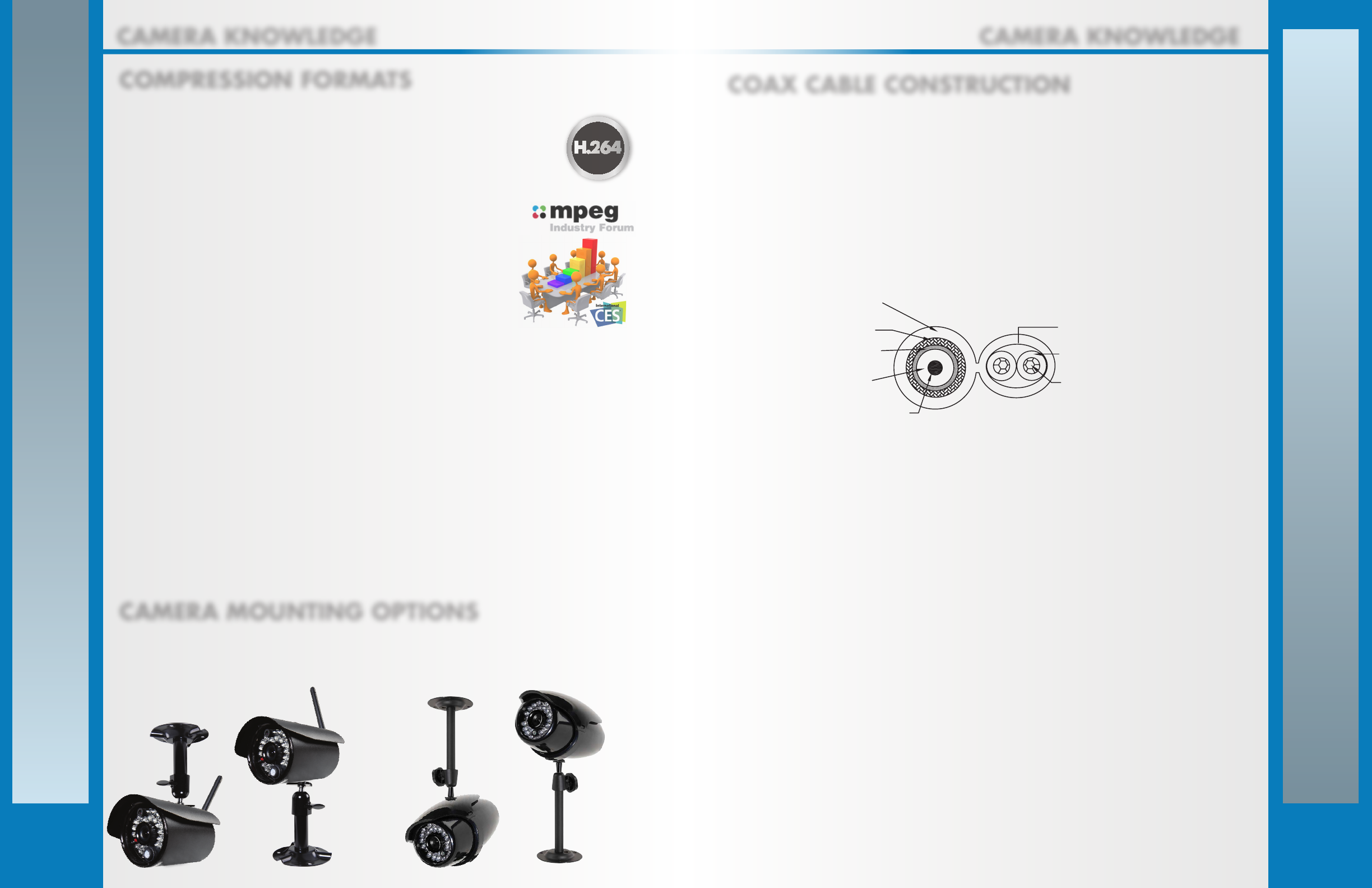
CAMERA KNOWLEDGE
CAMERA KNOWLEDGE
CAMERA KNOWLEDGE
CAMERA KNOWLEDGE
The foundation of these standards is JPEG, named after the group that developed
it in the mid-1980s, the Joint Photographic Experts Group. The first JPEG
standard was released in 1991. Another group of developers, in the late 1980s,
developed a standard for compressing moving pictures and audio - the Motion
Picture Experts Group, hence the name MPEG. MPEG-4 was released in 1998.
H.264/AVC (for advanced video coding), is the latest block-oriented motion-
compensation-based codec standard developed by the ITU-T Video Coding
Experts Group (VCEG) together with the ISO/IEC Moving Picture Experts
Group (MPEG), and it was the product of a partnership effort known as
the Joint Video Team (JVT). The ITU-T H.264 standard and the ISO/IEC
MPEG-4 AVC standard (formally, ISO/IEC 14496-10 - MPEG-4 Part 10,
Advanced Video Coding) are jointly maintained so that they have identical
technical content. H.264 is used in such applications as Blu-ray Disc, videos
from You Tube and the iTunes Store, DVB broadcast, direct-broadcast
satellite television service, cable television services, and real-time video
conferencing. The standardization of the first version of H.264/AVC was
completed in May 2003. Version 13 was implemented in March 2010.
H.264 provides good video quality at substantially lower bit rates than previous standards. Basically
it compares compressed images using the first compressed image as a reference frame, then it sends
only the parts of the following images that differ from the reference image. This substantially lowers
the amount of data that needs to be transferred making it more attractive for video network delivery
and the delivery of HD video. H.264 is an open format and is available for anyone to implement.
M-JPEG is the most widely used picture compression format used today and is a video
codec where each frame is separately compressed into a JPEG image. The resulting
quality of video compression is independent from the motion in the image. Each individual
image is a complete JPEG compressed image, unlike H.264 which uses reference images.
M-JPEG is ideal for courtroom evidence, whereas H.264 could be challenged as every frame is not
a complete picture. M-JPEG technology is simpler however uses more storage space. As images are
compressed, clarity can suffer. A balance needs to be drawn at reducing image size and keeping the
image clear. Latest versions of H.264 improve clarity.
COMPRESSION FORMATS
Most First Alert cameras can be either ceiling or wall mounted by simply reversing the mounting
camera stand. Holes are provided on both the top and bottom of the camera housing to accommodate
most mounting requirements. It’s important the camera is mounted correctly to ensure the image is not
upside down as the camera lens can only be positioned one way.
CAMERA MOUNTING OPTIONS
Not all coax cables are created equally. First Alert’s RG59 combined coax video and DC power cables
use a solid copper conductor for less voltage drop and better signal over longer distances. This also
makes the cable easier to handle versus other lower quality copper clad steel cables as it is less rigid
and will not remain coiled. In addition, the cables are double shielded with aluminum foil insulation
and braiding to help protect the video signal from interference. Each cable comes with BNC Male
connections on each end of the video cable and 1 jack male, 1 plug female on the ends of the DC power
cable (2.1mm I.D./5.5mm O.D.). We also supply two adaptor plugs for your convenience. One is a
BNC female to BNC female adaptor to provide a way to connect two lengths of cable together. The other
is a BNC Female to RCA male connector to attach cable to a TV RCA female (Yellow Video in) input. In
addition, we offer cable that is fire rated FT-4/CMR UL approved for in-wall installations. All of these
features ensure your customers of the highest quality installation.
COAX CABLE CONSTRUCTION
Jacket:Ø6.0±0.1mm
60PwhitejacketPVC
Braid:16/8/0.12mmCCA
Conductor:7/0.38mmCCA
PEInsulation:Ø1.8mm±0.05mm
red,blackHDPE5502+LDPEN150
Jacket:Ø5.0x3.4±0.1mm
60PwhitejacketPVC
Conductor:1/0.78mmbarecopper
FrothPE:Ø3.8±0.1mm
PE(HDPE+LDPE)
Wrap:14mmAluminumfoil
10
11









